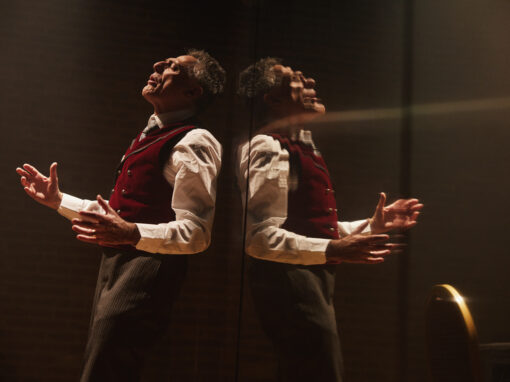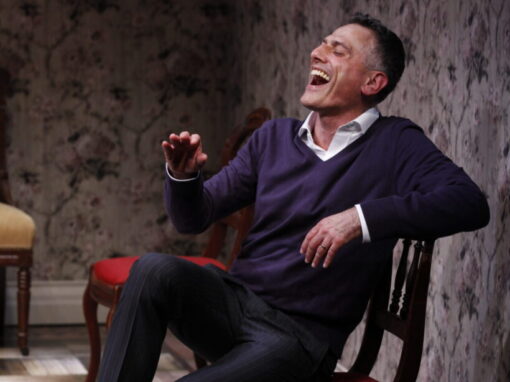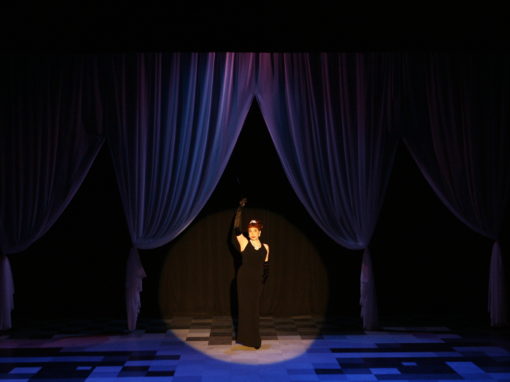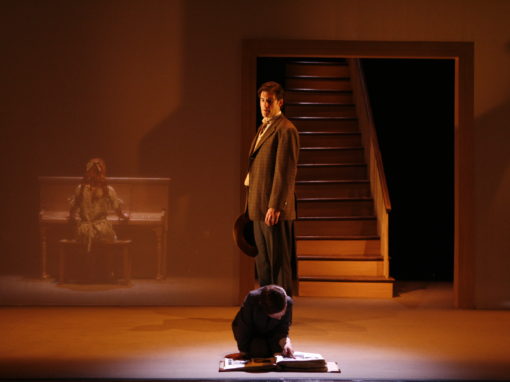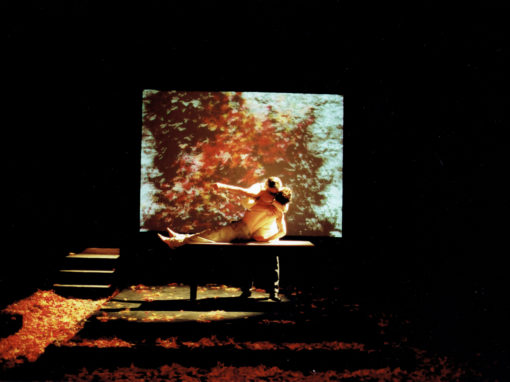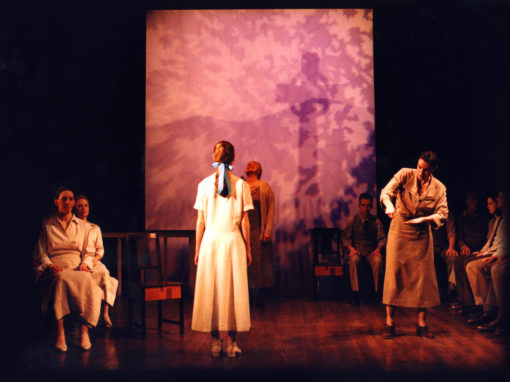In Pursuit of The Queen // by John Epperson
Legendary John “Lypsinka” Epperson raises the stakes of his lifelong relationship with ONCE UPON A MATTRESS.
Once Upon A Mattress was a seminal experience for me, and I needed to complete a circle around it. With the help of the inventive New York City theatre company Transport Group, I was able to round out the circle. I first remember seeing Carol Burnett in the 1964 television production of Mattress, along with Elliott Gould, Jack Gilford, Shani Wallis, and Jane White as Queen Aggravain. At age nine that kind of thing grabs you. Burnett filmed the show for television a second time in 1972, again with White and Gilford, plus Bernadette Peters and Sivi Aberg from The Gong Show four years later.
It has been suggested that a successful stage musical must be about at least one of two things: “How the world changed,” or, “How I found a family.” The Sound of Music, The King and I, South Pacific, Gypsy, and Hairspray fall into both categories. Some successful musicals such as Funny Girl (“How I lost my family”) and Company (“How I manage to remain ambivalent about emotional relationships”) don’t fall into either category. Once Upon A Mattress decidedly follows the latter equation about family. The musical book-writer Thomas Meehan (who wrote Annie, Hairspray, The Producers, but not Mattress) said he didn’t want to work on any musical unless the underlying story was myth-based. Mattress is three myths in one: primarily The Princess and the Pea, but also Cinderella, and The Ugly Duckling. And the final image of the show is misfit Princess Winifred, asleep, holding hands with her awkward but pleased Prince Dauntless. She has found her family.
Also, in 1972 I graduated from high school and went off to college. Soon after arriving at the Presbyterian school in Jackson, Mississippi (30 miles north of my hometown), I noticed a sign for auditions for the annual musical: Once Upon A Mattress. I hadn’t had an opportunity to be onstage as an actor since I was a sixth grader. And at age 17, I was now even shyer, more repressed, more blank-faced, more frightened, more introverted. In spite of all those drawbacks, I wanted to be an actor. Go figure.
I screwed up my courage and auditioned. The director cruelly cast me against type—as Sir Studley. This was indeed the least studly Studley the world had seen. But I loved the whole process. I loved the other kooks onstage, especially the funny, charismatic actress who played Princess Winnifred the Woebegone. (I still love her; we are still friends.) She had actually graduated from the school the year before but the director had talked her into signing up for one class the first semester so she could play the lead in Mattress!
I loved the mechanics of putting on a show, and how backstage is as choreographed as onstage. There were only three performances. And I got laughs. But…wait. I wasn’t intending to be funny. They were laughing at me, the clueless kid. At the next performance, I flipped that around and decided that I was funny, and the audience would laugh with me. It worked. More laughs. And then I was hooked. I’ve been a laugh whore ever since.
During those college years I was also in The Boy Friend, Bye Bye Birdie, and off-campus, Boy Meets Girl, How To Succeed In Business…, and Little Mary Sunshine. I saw the original Equity bus-and‐truck Broadway tours that stopped in Jackson for one night, including No, No, Nanette (with Evelyn Keyes from Gone With The Wind), Applause (with Pia Zadora as… “Pia”), Promises, Promises, and Company with Julie Wilson and Allen Case who had been the original Sir Harry in Mattress with Burnett. Experiencing these shows made me want to go to Manhattan and see the place where the productions got started. My mother and I had never been on an airplane before and had never been north of the Mason-Dixon Line when we saw on Broadway Liza Minnelli replace Gwen Verdon in the original Fosse production of Chicago in August 1975, and we experienced a preview of A Chorus Line not knowing what we were walking into. This cemented my love for theatre, and I resolved to move to New York City, an event that took place three years later.
Of course, when I arrived, I realized I was not trained for the tough milieu that the New York theatre scene is. I didn’t know how to go to an audition and deliver the goods. I realized that when I was cast in Mattress at school it was because…everyone who showed up to audition was cast! Bodies were needed. So, I bided my time, and when I discovered the wild artistic goings-on in the East Village in the late 1970s and early ‘80s, I realized I could create my own theatrical efforts, and I could be a female character. John Epperson could hide behind the clothes, makeup, and a wig and be the alpha person he was not in real life. Thus, Lypsinka was born.
As I pondered over the years the various possibilities for me in female garb, it had occurred to me that I could play Princess Winnifred myself. I had a stronger vocal ability at one time. But as those years went by, I decided I might be better cast as Queen Aggravain. In 2004, I was onstage as The Stepmother in New York City Opera’s production of Rodgers and Hammerstein’s Cinderella. In 2005, Burnett played Aggravain in yet another television version of Mattress. Those two productions made it even more apparent that: 1. I could do it and 2. It’s a starring role. I even tried to convince New York City Opera to do Mattress and I was basically shooed out of their Lincoln Center office.
In 2007 my friend Mart Crowley, another Mississippian and author of The Boys in the Band, moved from Los Angeles back to New York. Mart was friendly with the writer Dominick Dunne (Dunne had produced the original movie version of The Boys in The Band in 1970) and Jack Cummings III, the risk‐taking Artistic Director of Transport Group, knew Dunne. So, Crowley and Cummings were now connected and planning an Off-Broadway revival of Mart’s play. Through Crowley I met Cummings.
My own wheels were, and are, always turning, and I realized my dream of doing Mattress again was not going to happen unless I instigated it. I had worked with another laugh whore, Jackie Hoffman, a few times, so I called her up. “Have you ever thought of playing Winnifred in Once Upon A Mattress?
“Well, yeah,” was the response, “but don’t you think I’m a little long in the tooth?”
“It doesn’t matter,” I said. I managed to get a copy of the script and organized a table reading that included Misty Copeland, a newbie to non‐ballet acting. I invited Jack Cummings but he was out of town. However, he thought it was a great idea, and banked the idea in his list of possibilities.
Around the time of the table read, another person I had met through Mart Crowley died, a former producer and great gentleman (and widower of the actress Hope Lange), Charles “Chuck” Hollerith. I went to Chuck’s funeral and at the reception someone pointed out that Mary Rodgers, the composer and rights-holder of Mattress—and daughter of Richard Rodgers—was there. Once again, I managed to pull together my nerve and I introduced myself to Ms. Rodgers. I blurted out, “I hope to play the Queen in Once Upon A Mattress someday.” She chuckled and said, “There are lots of possibilities for gender play in that show,” and walked away.
As if it weren’t enough that Chuck died in 2011, so did the Black actress Jane White. I met Jane about ten years before she died. Jane’s father was Walter White and was the Executive Secretary of the NAACP. He died in 1955, and didn’t see his daughter play Queen Aggravain four years later in the original production of Mattress. So, you see there was inclusive casting on Broadway even then, although rare. She did have to jump through some hoops to get the role, but once in rehearsal Director George Abbott was taken with her and said to the creators, “I think our Queenie needs a song,” and the writers successfully complied.
Jane was classically trained and had a big career, even playing speaking parts at The Metropolitan Opera. By 2001, however, Jane’s career had slowed down and she was trying writing. She was also an avid reader and had a great deal of knowledge about the Marie Antoinette era. She wrote a play about the backstage lives of two actresses, who easily could have been Jane and her best friend Carrie Nye (Mississippi wife of Dick Cavett). Someone suggested to her that perhaps the two ladies should be played by men, and that person suggested me. She tracked me down and Jane and I met for coffee in the West Village near her home to discuss the matter. Jane’s play never happened but we remained friends.
In 2010, Jane invited me to a memorable birthday event for the head of The Metropolitan Opera Guild at The Lesbian, Gay, Bisexual & Transgender Community Center on West 13th Street, also near her home. As I was walking her back to her place, she told me she had emphysema from smoking: “And, darling, I don’t regret one puff!” Best pal Carrie Nye had already died from smoking. When Jane died it turned out she had a list of names of friends and numbers to be called to deliver the unfortunate news. It moved me when I got the call: I was on Jane’s list.
Two years after Jane’s death, Jack Cummings called me and said he hadn’t forgotten about the idea of doing Mattress with Jackie and me. Would I be interested in doing it as a Transport Group one-night benefit concert? There would be an orchestra and a full cast. The entire book would be read and all the songs sung. This kind of thing is difficult to do because it’s pulled together very quickly with little rehearsal. However, I said yes. Perhaps it could lead to a full production.
The event took place in late spring of 2013 and Mary Rodgers was in attendance with her family and others. They were all clearly seen by the actors in the fourth row. As Mary later said, “I could feel the love when I walked in the room.” Lypsinka and Jackie fans were there, fans of the Golden Age of musicals were there, and Mary needed to feel that love because the 1996 Broadway revival of Mattress was not the success that had been hoped for.
Mary had agreed to do a Q&A with Jack Cummings at the end of the performance, and it took a while for her to get onto the stage because she had COPD. During the discussion with Jack, she admonished the audience, “Don’t ever start smoking!” (Unlike Jane, she did regret the puffs.)
Everyone left happy. A couple of days later I mentioned on Facebook that the night was a success, but my only regret was that I didn’t get to meet Mary Rodgers. A Facebook follower named William Baldwin Young popped up and wrote, “I can arrange that.” It turned out that Mr. Young was Mary’s assistant, and I was invited to lunch at Mary’s home, a fabulous apartment in the fabulous building The Beresford on Central Park West, with a fabulous grand piano in the main room and beyond that a fabulous view of the park. Mary’s husband, Hank Guettel, did not join us. He had come to the concert performance but was not feeling well and he was in the next room. Mary was now wearing on her nose a tube for oxygen, and the tube was very long, connected to an unseen oxygen tank. The long tube allowed her to move around the apartment without worrying about the tank. As we had our lunch, she talked cheerfully about how much she enjoyed the performance and Jackie in it, and said, “I’d like to have a full production.” This was what I was hoping for! We sat for photos together and she held my hand and called me “my boyfriend.” We exchanged phone numbers and e-mail addresses and we were new friends. From friends with Jane to friends with Mary, just like that.
In October that year Mary’s husband Hank, who I never met, died. The day before Thanksgiving there was a memorial for him at Lincoln Center and I was invited. Afterwards people were gathering around Mary to speak with her. She was seated and wearing her oxygen tube, looking very frail. She had not seen me since that lunch date and when I went up to her to say hello, I could tell she didn’t know me. I said, “I’m Lypsinka!” She grabbed my wrist and said, “Oh! What are you doing tomorrow?” Nothing.
And the next day, I was seated next to Mary at her family Thanksgiving meal. As the meal was coming to an end, she said, “Next time you must play the piano.” Thinking there might not be a next time, I said, “What if I play a little bit before I go?” Fine.
We adjourned to the living room, and I found myself before the family of Richard Rodgers leading a sing‐along of his tune (and Sondheim’s) “Do I Hear A Waltz?” and Mary’s composition “Sensitivity” (from Mattress). This is why I moved to New York, I thought.
Occasionally Mary would say something very revealing. One day, when we were discussing her musical relationship with Richard Rodgers, she let fly, “My father was a very good teacher, but he was disappointed that my sister and I didn’t look like chorus girls.” And then I realized Mattress is not about Princess Winnifred or Carol Burnett; it’s about Mary, the daughter of the King of Broadway and the formidable Dorothy Rodgers—this bright, talented, engaged offspring searching for her own way through life, looking for the right spouse, the right sexual partner.
Mary and I had one more in-person appointment. She called to say that before her husband had died, they had in hand tickets to see the young, rumpled pianist Daniil Trifonov at Carnegie Hall in early February 2014. Serious classical music was probably Mary’s greatest artistic passion, not Broadway show tunes. She asked me if I would like to go with her and I said yes. I met her at the famous hall and she had with her an important executive from the Cleveland Institute of Music where Trifonov was going to school. I found out the executive and the keyboard wunderkind had been at Mary’s apartment the night before so Trifonov could practice on her excellent piano. This was Mary Rodgers; the greats came to her.
She also had with her a portable oxygen tank, which she apparently had never used previously, and never would again. We had the best seats in the house, second tier, house left, in the front row of a box, with an excellent vantage point of the keyboard.
The 22-year-old pianist came on to play a Stravinsky piece in four movements. Between movements he paused. In the expectant quiet of the great hall with its excellent acoustics, I heard a faint hum. What could that be, I wondered. The next movement started, and then I realized: it was Mary’s oxygen. Never mind, I thought, it’s the slightest of white noise.
When the piece was done, and the mop-top pianist went off stage, a man behind us said, “Would your mother mind turning off her oxygen during the concert? It’s what my mother does.” Mary, of course, heard this, and she panicked. She thought she was ruining the evening. In retrospect, perhaps I should have said, “Do you realize the talented prodigy you are listening to tonight was practicing at this lady’s home twenty-four hours ago?” But I don’t think Mary would have liked that. She didn’t crow about herself. And now she was worried she was ruining an evening for others.
The man from Cleveland came up with the idea that we would switch seats with people in the last row of the box. That way, at the last minute before the second part of the program, we could put the tank in the semi-‐private anteroom between the hallway and the box. And this we did, but I could see Mary was still upset and looking at me with pleading eyes. She managed to focus on the stage for the second part of the bill, or seemed to, but I could not. Because I could see that the tube from Mary’s nose to the tank behind the door, was just over the foot of a man not in our party. All I could do was look at that man’s foot hoping he didn’t cross his legs and pull the tube away from Mary’s nose. I could have pointed the potential problem out to the man, but then Mary would have noticed too and she would be even more panicked.
At the beginning of the second intermission the man from Cleveland said he had to go away for a few minutes, perhaps backstage to see his protégé. Mary said she needed to go to the ladies’ room. I managed to get her up a couple of steps in that direction, which was not easy for her, but then she realized I couldn’t go in with her and she needed help walking, especially since she also had to carry the tank. Earlier in the evening I had seen a lady I knew in the hallway of the second tier, and I wished she was there now to help. But Mary was a proud person, and I don’t think she would have liked my asking my friend for help. She resigned to go back to the box, and thankfully the man from Cleveland reappeared. Mary said she wanted to go home. The man convinced her to go into the anteroom. She sat for a minute and then said she wanted to go home, and she called her driver. She insisted we stay for the rest of the recital, but we did get her to the street and into her car. The driver, she said, would get her into The Beresford and the doormen would get her upstairs. As she got in the car, she looked at us. The look said—what? Scared? Frail? Embarrassed? Regretful? Trapped by existence? All of the above and more? It was the last I saw the spectacular, complex, benevolent Mary Rodgers.
And like husband Hank, there was also a memorial service for Mary, this one at Town Hall. Carol Burnett and Julie Andrews paid tribute together. Sondheim played at the piano a piece he composed for the occasion, since apparently words would not suffice. (The character named “Mary” in his Merrily We Roll Along, the character with the unrequited love for the songwriter, was not for nothing. Mary and Sondheim basically grew up together under the noses of Papa Rodgers and surrogate-Papa Hammerstein.)
As for the Transport Group full production of Mattress that Mary wanted, she did not get to see it. Clearly and cleverly and colorfully directed by Jack Cummings III and choreographed by Scott Rink, the laugh whores onstage were happy (there were more laugh whores then just me; I counted at least seven) and, most importantly, the audience was happy. Innovation-prone Transport Group seemed to think the casting of Jackie and me was one of the innovations. I had to combine John Epperson the actor with his creation Lypsinka, and the character of Aggravain. My m.o. was: “What if Kay Thompson was a fascist?” Would Jane have been amused? Would Mary have been pleased? I like to think so. My circle was complete, although real completion would have been a transfer of the unique production. And Mary would have “felt the love” at every performance.
EPILOGUE: Not only did the audience enjoy Transport Group’s Off-Broadway revival, but so did the critics. In spite of, or perhaps because of, the good reviews, the post-Mary rights-holder did not allow the production to continue, not even a cast recording that would have preserved the sparkling new musical orchestrations and arrangements by Matt Castle and Frank Galgano and Jackie’s inspired performance, as well as the entire talented singing part of the cast. There was a rumor that a larger theatrical non-profit with direct Broadway connections would be putting up their own production starring a gifted but non-clown actor to play Winnifred. To date, over six years later, that production has yet to happen. A bit of trivia: Mattress and The Sound of Music both opened in 1959, and both were Tony-nominated for Best Musical. The Sound of Music won the award, which probably kept peace within the Rodgers family. It seems Mattress is still the whipping boy manipulated to assuage any possible Freudian eruptions.

About the author:
John Epperson (aka Lypsinka) was born in Hazlehurst, Mississippi. Film acting credits include Black Swan, Witch Hunt with Dennis Hopper, Wigstock: The Movie, Angels in America, Kinsey, Vampire’s Kiss and Another Gay Movie. Theatre actor credits include Wallace Shawn’s Evening at the Talk House (Off-Broadway, 2017), Once Upon A Mattress (Off-Broadway, 2015), John Epperson: Show Trash, Lypsinka! The Trilogy (both 2014), I Could Go On Lip-Synching, Now It Can Be Lip-Synched, Lypsinka! A Day In The Life (2 Drama Desk nominations), As I Lay Lip-Synching, Lypsinka Must Be Destroyed!, Lypsinka IS Harriet Craig!, Lypsinka! The Boxed Set (Washington, D.C. Helen Hayes Award Outstanding Non-Resident Production, L.A. Weekly Theatre Award Best Solo Performance, Drama Desk nomination), The Stepmother in NYCO production of Rodgers and Hammerstein’s Cinderella at Lincoln Center; The Passion of the Crawford (a fantasia on the personality of Joan Crawford), and a cabaret show John Epperson: The Artist Principally Known As Lypsinka. Writing credits include a play – My Deah: Medea For Dummies (Obie-winning production), 2 stage musicals – Ballet of the Dolls, Dial “M” For Model, and half a play – a rewrite of James Kirkwood’s notorious Legends! produced at Studio Theatre in D.C. Mr. Epperson has also written for Time, The Guardian, The New York Times, The Washington Post and Interview. He was the guest curator of the Club 57 film series You Are Now One Of Us at The Museum of Modern Art 2017 – 2018. As a film historian, he has lectured about movies for MoMA, The New School, Anthology Film Archives and The Academy of Motion Picture Arts and Sciences. Epperson and Lypsinka are the subjects of an Emmy-winning television documentary for PBS. www.lypsinka.com

Explore Our Past Shows
